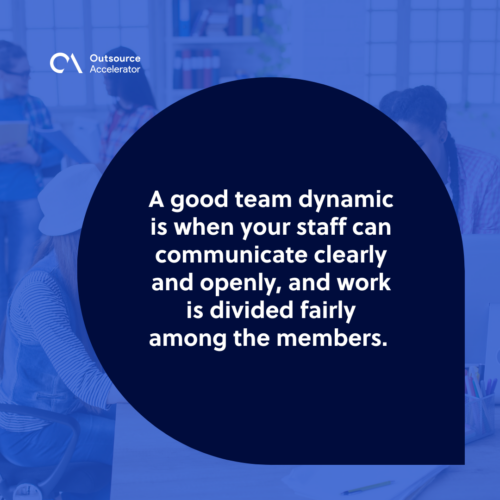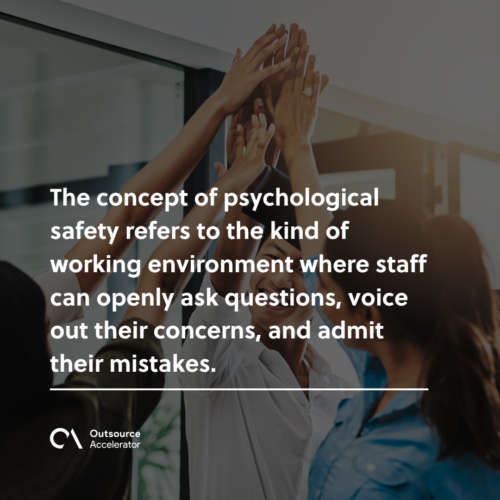Understanding workplace dynamics and their impact on your organization

In some cases, organizations tend to overlook the working environment as they put more focus on productivity and profits. This is exactly where companies usually face undesirable outcomes.
A huge part of an organization’s success is its hard-working and dedicated staff. Your workplace dynamics can particularly encourage your teams to perform above and beyond or get left behind by the market competition.
In this article, let’s examine the fundamentals of workplace dynamics. Why should business leaders value them? How does it affect management and employees? More importantly, what can organizations do to enrich their workplace dynamics?
Meaning of workplace dynamics
The company culture is integral to establishing and maintaining a thriving organization. A typical workplace setup encompasses a diverse group of individuals working together to achieve common goals.
However, your employees may have their views and expectations of an ideal working environment. This is where workplace dynamics come into play.
Workplace dynamics refers to the way your people interact, engage, and collaborate. This includes their behavior, assumptions, and entire understanding of the workplace environment.
Your workplace dynamics not only play an important role in your overall success. It also has a deep and lasting impact on your staff. It can particularly affect their well-being and career path.

Why your workplace dynamics matter
Every workplace has its own culture, management style, and employees with different personalities. While office politics can be an unavoidable circumstance, many employees would agree that it has a significant effect on their overall performance.
In reality, everyone aspires to achieve a certain level of power within your organization, even if in the slightest means of getting their voice heard.
Good workplace dynamics exist when employees remain respectful to one another despite individual differences and distinct working styles. Ideal workplace dynamics also exude trust from upper management down to the lower-level employees.
That said, workplace dynamics matter in shaping a positive work culture and work relationships. They keep employees motivated and fulfilled, no matter how challenging the job may be.
Indeed, workers may not always find a job in the field that’s personally meaningful to them. However, it is the organization’s responsibility to build a kind of working environment that recognizes its employees.
Remember that you can always turn your employees into your strongest assets by reinforcing your work dynamics.
To help you understand this concept more, here we have outlined some of the frequently asked questions regarding workplace dynamics.
What makes good team dynamics?
The most effective teams are composed of individuals whose special skills complement each other. These people delight in working together and have high respect for each other, even in times of disagreement.
Strong workplace dynamics are built on effective communication, mutual respect, and collaboration among team members.
In the era of remote working, maintaining team dynamics becomes even more pivotal.
A good team dynamic is when your staff can communicate clearly and openly, and work is divided fairly among the members.
Prioritizing employee engagement by recognizing accomplishments, providing opportunities for professional growth, and promoting a supportive culture can significantly boost team dynamics and overall productivity in any work setting.
However, you should also be aware that not all teams may naturally work well together. In this case, your employees will need proper guidance and extra management.
Doing so will help them overcome individual differences so that they can function well and be at their best.

What makes employees happy and satisfied at work?
According to research, these are the four factors that make employees feel happy and satisfied at their work:
- Sense of belonging
- Inclusion at work
- Autonomy
- Flexibility
Although some business leaders may consider compensation and appreciation ineffective, they also have big implications for employees’ well-being.
How do we address workplace conflicts?
There are various ways to approach a workplace conflict. As per some organizational psychologists, there are five conflict management styles in the workplace:
- Diplomat – employees who settle for bargains that benefit them the most.
- Ostrich – workers that stay away from conflicts at all costs.
- Warrior – energized by conflict and may always seek it out.
- Sage – concerned about the well-being of the people involved. They look for solutions that will result in the best outcome for everyone.
- Philanthropist – the people-pleaser; they want the conflict to dissolve quickly by yielding to others’ needs.
Needless to say, not all conflict management styles work. The best approach to workplace conflict is the Sage, which encourages communication and cooperation within the team.
What does ‘psychological safety’ mean?
The concept of psychological safety refers to a working environment in which staff can openly ask questions, voice concerns, and admit mistakes.
They are confident enough that they will not be ignored, criticized, or penalized by the upper management, hence the sense of being safe psychologically.

What causes employees to be unhappy at work?
Among the leading causes of unhappiness at work are a lack of work-life balance and job security, as well as few opportunities for social connection.
Workplace dynamics: How to spot an unhealthy workplace environment
An unhealthy or toxic environment has negative workplace dynamics that can affect your employees’ welfare. It may result in serious conflicts among staff and slow down workplace productivity
Here’s how you can tell if your workplace is becoming an unhealthy environment for you and your employees:
Lack of proper communication
Poor communication is when your staff does not feel comfortable enough to engage with the management, especially when they are about to relay bad news. This is caused by the fear of a negative response.
As for the superiors’ end, the lack of proper communication results in unclear instructions and undetermined priorities.
Verbal abuse
Verbal abuse happens when insults and offensive statements are thrown at people, making them feel belittled or threatened. It can also be in the form of rumors spread throughout the organization.

Biased workloads
Unbalanced workloads occur when some employees have little to do compared to others who have to work extra long hours to complete their tasks.
This can propel employees to resent their coworkers or the management and may lead to them leaving the company.
Negativity
You can’t expect your employees to be joyful and highly motivated at work all the time. Nonetheless, if they often feel anxious at work, it will most likely have a long-term effect on their well-being and morale.
A toxic or negative work environment can have severely damaging effects on a person’s mental health. It can be linked to depression, anxiety, and burnout. It can also affect your staff’s physical health.
How to improve workplace dynamics
Good workplace dynamics are when everyone in your organization works together and in collaboration to achieve common goals.
Below, we have four tips to help you achieve and maintain healthy workplace dynamics that both your management and employees will benefit from:
Determine how individual personalities affect workplace dynamics
As you can see, each member of your organization has their own set of skills, personality, and working style. Being able to recognize your employees’ strengths and differences lets you know how each person fits your organization.
Doing so also allows you to bridge gaps between workers with different experiences or behaviors. Your employees should know that their contributions are as important and valuable as everyone else’s within the organization.
Strong leadership is crucial
It is your management’s responsibility to guide and support your employees on the path to achieving the company’s goals.
Clearly define your employees’ roles and responsibilities, and divide tasks appropriately. Create a timeline for your projects so everyone can fully understand their responsibilities.
Communication is always the key
Keep open and transparent communication within your organization. This will cultivate trust and loyalty among your staff so you can all work harmoniously to achieve your goals.
You should also make sure that your workers can effectively communicate information, ideas, or concerns to upper management. You can have them attend training sessions on how to present the information needed to be shared throughout the organization.
Be aware of cultural sensitivities and diversity
Companies that have solid diversity and inclusion initiatives fuel creativity and innovation.
To foster diversity, your management must acknowledge everyone from different backgrounds, regardless of age, race, culture, sexual orientation, and gender.
When your employees feel like they are being heard and that their opinions matter, it will encourage more productivity on their end.
More importantly, you need to ensure that your employees are respected, treated well, and compensated fairly. You should also give them a fair amount of autonomy and flexibility in performing their tasks.
Further, good workplace dynamics should take into account employees’ mental health. One excellent way you can help promote employee wellness is by giving them access to mental healthcare either through insurance or employee assistance programs.







 Independent
Independent




